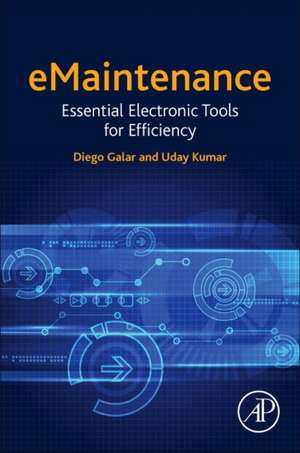eMaintenance: Essential Electronic Tools for Efficiency
Autor Diego Galar, Uday Kumaren Limba Engleză Paperback – 14 iun 2017
The book provides an introduction to collecting and processing data from machinery, explains the methods of overcoming the challenges of data collection and processing, and presents tools for data driven condition monitoring and decision making. This is a groundbreaking handbook for those interested in the possibilities of running a plant as a smart asset.
- Provides an introduction to collecting and processing data from machinery
- Explains how to use sensor-based tools to increase efficiency of diagnosis, prognosis, and decision-making in maintenance
- Describes methods for overcoming the challenges of data collection and processing
Preț: 779.23 lei
Preț vechi: 1024.70 lei
-24% Nou
Puncte Express: 1169
Preț estimativ în valută:
149.12€ • 161.93$ • 125.26£
149.12€ • 161.93$ • 125.26£
Carte tipărită la comandă
Livrare economică 15-29 aprilie
Preluare comenzi: 021 569.72.76
Specificații
ISBN-13: 9780128111536
ISBN-10: 0128111534
Pagini: 552
Dimensiuni: 152 x 229 x 31 mm
Greutate: 0.79 kg
Editura: ELSEVIER SCIENCE
ISBN-10: 0128111534
Pagini: 552
Dimensiuni: 152 x 229 x 31 mm
Greutate: 0.79 kg
Editura: ELSEVIER SCIENCE
Public țintă
Reliability and Maintenance Engineers with an interest in Industry 4.0. Researchers in the field of Industry 4.0, manufacturing, and machinery.Cuprins
1. Sensors and Data Acquisition2. Data Collection3. Preprocessing and Features4. Data and Information Fusion From Disparate Asset Management Sources5. Diagnosis6. Prognosis7. Maintenance Decision Support Systems8. Actuators and Self-Maintenance Approaches
